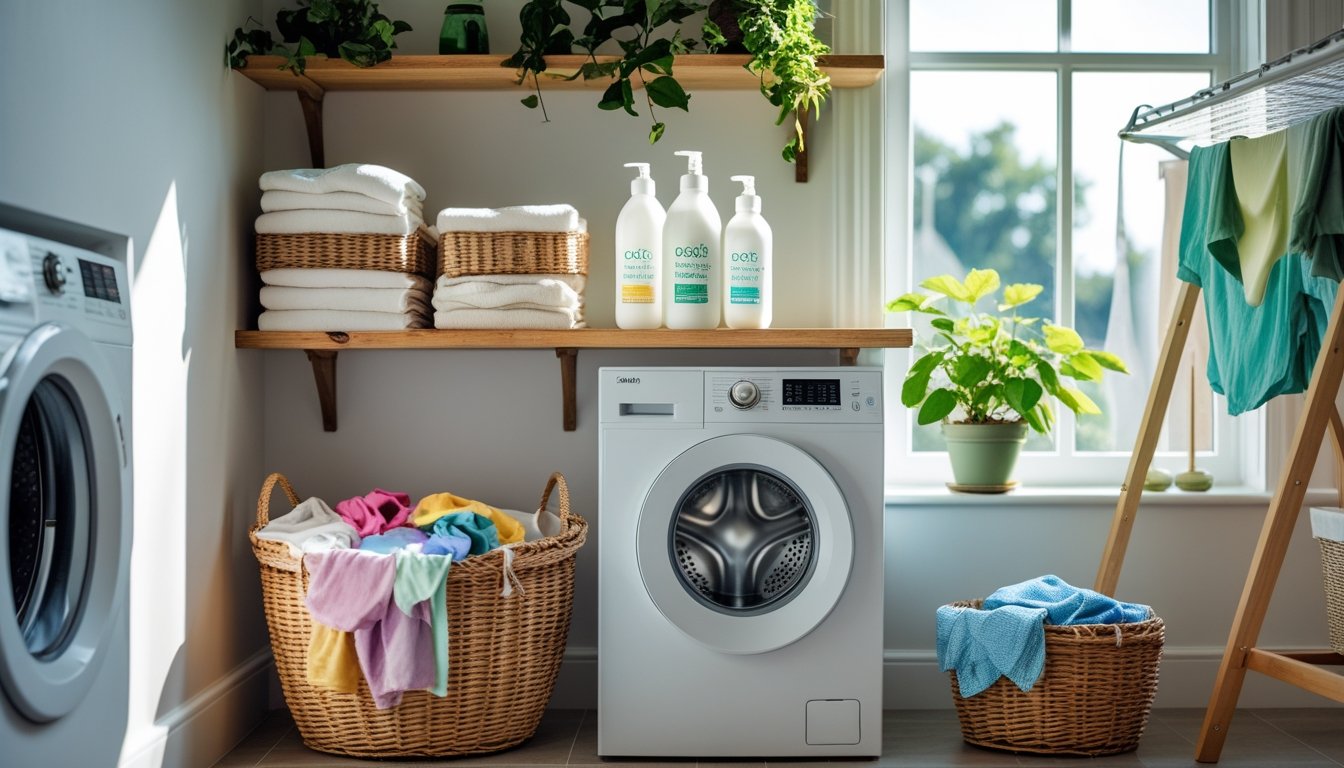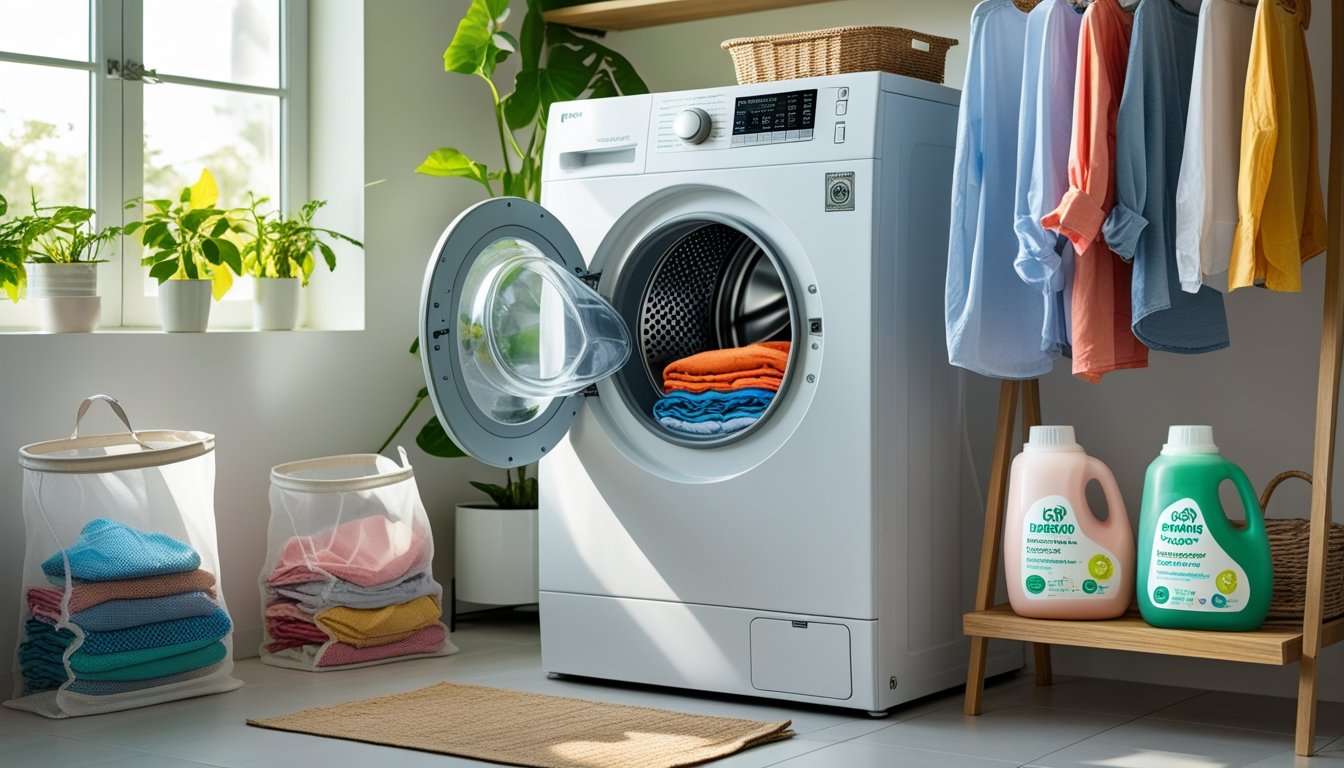Late updated: 13 Aug 2025 13:08
Written by: Sarah Hollister
Sustainable Tips For Eco-Friendly Laundry Practices: Effective Ways To Save Water And Energy
Our daily laundry habits significantly impact the environment, often in ways we don't immediately realise. By integrating eco-friendly practices into our laundry routines, we can reduce water and energy consumption and ultimately lower our carbon footprint. Simple changes, like opting for cold water washes and line drying, not only benefit the planet but can also extend the life of our clothing.

Choosing sustainable detergents and reducing wash frequency are essential steps. Eco-friendly detergents, free from harmful chemicals, ensure that less pollution enters our waterways. Similarly, washing only full loads can conserve water and energy, making each cycle more efficient.
We also explore advanced techniques like incorporating reusable accessories and repairing items to cut down on waste. Through these practices, we're not only caring for our clothes but also making meaningful contributions to a healthier planet.
Key Takeaways
- Simple habit changes can greatly impact the environment.
- Sustainable products and practices are central to eco-friendly laundry.
- Advanced strategies enhance our eco-efforts and promote sustainability.
Core Strategies For Sustainable Laundry
Adopting sustainable laundry practices involves making conscious choices about how we wash, the products we use, and optimising the efficiency of our machines. Each strategy helps minimise environmental impact while maintaining a fresh and clean wash.
Optimising Loads: Wash Full Loads Only
Washing full loads is a straightforward way to maximise energy and water efficiency. By doing this, we ensure that the washing machine's resources—both in terms of electricity and water—are utilised fully per cycle. Opting for full loads means fewer overall cycles, translating to significant energy savings over time.
Using energy-efficient appliances marked with the Energy Star label further improves energy conservation. HE (high-efficiency) washing machines are specifically designed to clean effectively with lower water and energy use. When paired with full loads, they greatly contribute to a sustainable laundry routine and help reduce our carbon footprint.
Choosing Cold Water To Save Energy
Switching to cold water washing is a simple adjustment with significant benefits. Heating water for laundry accounts for a large portion of energy use. By opting for cold water settings, we can cut energy consumption significantly without compromising the quality of our wash.
Many modern detergents are formulated to work effectively in cold water. This makes it easier to maintain clean clothes while saving energy. Furthermore, washing in cold water helps preserve fabrics and colours, extending the life of our garments and further promoting sustainable living.
Selecting Eco-Friendly Laundry Detergents
Eco-friendly laundry detergents offer a viable alternative to conventional products. These detergents typically contain biodegradable ingredients and avoid harsh chemicals, making them a healthier choice for both the environment and our skin.
Plant-based detergents can be an effective, sustainable option as they come from renewable resources. When choosing such products, it's wise to look for certifications by agencies like the Environmental Protection Agency, ensuring the product meets eco-friendly standards. Liquid detergents and washing soda can also be effective while being less harmful to aquatic ecosystems.
Reducing Detergent and Fabric Softener Usage
Using the correct amount of detergent and fabric softener can significantly affect the sustainability of our laundry routine. Overuse not only wastes products but can also harm the environment and our washing machines. It's important to follow the manufacturer's instructions for the right dosage.
Consider reducing or eliminating fabric softener altogether. Many fabrics don't require it, and alternatives like wool dryer balls can soften clothes without chemicals. Reducing these products saves money and minimises our laundry's environmental impact. By being mindful of our product usage, we contribute significantly to sustainable laundry practices.
Advanced Eco-Friendly Laundry Practices

Our journey into eco-friendly laundry practices leads us to explore methods that minimise both water and energy usage while reducing the environmental footprint of our regular laundry routines. By utilising advanced techniques and sustainable products, we can ensure that our laundry day is not just effective but also gentle on our planet.
Minimising Water Usage and Preventing Water Pollution
One of the pivotal steps in creating a more sustainable laundry system involves reducing water consumption. Energy-efficient appliances are designed to use significantly less water. These washing machines often come with sensor drying functions that adjust the washing process based on the load size and dirt level.
Alternatively, when operating traditional laundry methods, it's advisable to wash only when we have full loads. This practice helps conserve both water and energy. Environmentally friendly detergents play a crucial role in this process. They break down easily, reducing the risk of water pollution. Ensuring that our detergent choice is biodegradable tackles water pollution and maintains aquatic life integrity.
Air Drying and Using Efficient Dryers
Air drying is a straightforward yet effective method to cut down energy use. Hanging clothes outside or using an indoor drying rack allows clothes to dry naturally without the need for additional heat. This approach not only conserves energy but also benefits fabric longevity by reducing wear and tear.
For those situations where air drying isn't feasible, investing in energy-efficient dryers with sensor drying capabilities becomes essential. These appliances adjust drying time automatically, avoiding over-drying and further saving energy. Efficient dryers are an excellent option for limiting the environmental impact while ensuring clothes come out dry and fresh.
Switching To Wool Dryer Balls and Avoiding Dryer Sheets
Wool dryer balls are an excellent alternative to traditional dryer sheets. By inserting a few wool dryer balls into the dryer, we can reduce drying time significantly. They help in separating clothes, which improves air circulation and reduces static cling. Unlike dryer sheets, wool dryer balls are reusable, making them both cost-effective and sustainable.
Using dryer balls also means we avoid conventional fabric softeners, which often contain chemicals detrimental to the environment. By switching to these eco-friendly options, our laundry day becomes green without compromising on the softness and freshness of our clothes.
Capturing Microfibres and Reducing Environmental Impact
Microfibres shed from synthetic fabrics during the washing process are one of the least visible but most pervasive pollutants. Adding a microfiber catcher to our washing routine can capture a significant amount of these microfibres, preventing them from entering our water systems.
Investing in items like microfiber filters for washing machines is also beneficial. Such devices trap the fibres before they drain away, significantly reducing our laundry's environmental impact. By taking these steps, we contribute positively to protecting our water bodies from fibre pollution, ensuring a cleaner and greener future.
Frequently Asked Questions

In our journey towards sustainable laundry practices, we can reduce energy use, choose effective eco-friendly detergents, and minimise water wastage. Understanding the impact of different laundry cycles and reducing plastic use can also help protect the environment.
What are the best practices for reducing energy use while doing laundry?
Using cold water settings significantly cuts energy consumption. Energy-efficient washing machines and drying clothes naturally, like air-drying, are effective strategies. Full loads maximise efficiency and save energy per garment washed.
Which eco-friendly laundry detergents are most effective for washing clothes?
Eco-friendly detergents derived from plant-based ingredients are effective and safer for the environment. Biodegradable brands without phosphates or harsh chemicals are recommended as they clean efficiently while impacting less on waterways.
How can one minimise water wastage when washing laundry?
Opting for high-efficiency machines that use less water can be beneficial. Washing full loads ensures water is used optimally. Simple practices like adjusting the water level setting according to the load size can also help.
Are there any specific laundry hacks to extend the life of clothing?
Washing clothes less frequently and using gentle cycles can preserve fabric integrity. For delicate items, air drying instead of machine drying prevents wear. Turning garments inside out before washing reduces fading and pilling.
What is the impact of different laundry cycles on the environment?
Shorter cycles reduce energy and water use, making them environmentally friendly. Choosing cycles that use lower temperatures also minimises energy consumption. By focusing on the right cycle for the material, we further lessen environmental impact.
How can reducing plastic use in laundry routines contribute to a lower carbon footprint?
Choosing reusable laundry containers drastically cuts down plastic waste. Implementing tools like microfibre filters prevents microplastic pollution in oceans. By reducing plastic consumption in laundry products, we contribute significantly to decreasing our overall carbon footprint.
